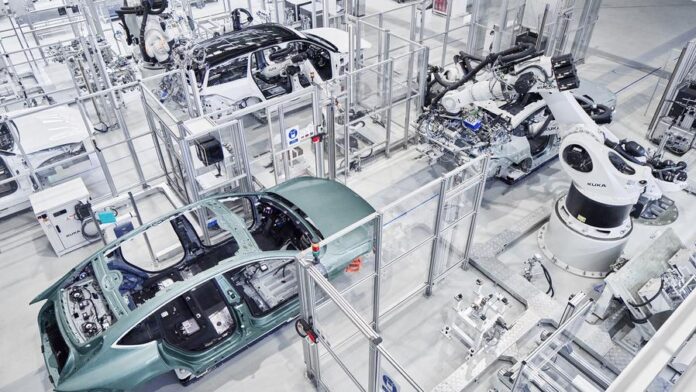By Li Xinping, Huang Fute, Lin Lili
This year, various regions and departments in China have been actively developing new quality productive forces, seeking new strategies and taking proactive measures.
Deputies to the 14th National People’s Congress (NPC) and members of the 14th National Committee of the Chinese People’s Political Consultative Conference (CPPCC) stressed the importance of vigorously developing strategic emerging industries such as new energy, new materials, advanced manufacturing, and electronic information.
They believe this will help foster future industries, accelerate the development of new quality productive forces and enhance the momentum for high-quality development.
With innovation playing the leading role, new quality productive forces mean advanced
productivity that is freed from traditional economic growth mode and productivity development paths, features high-tech, high efficiency and high quality, and comes in line with the new development philosophy.
New quality productive forces are in essence advanced productivity that features innovation and focuses on high quality, which are of great significance for accelerating the development of a modern industrial system, said Yu Xubo, a deputy to the 14th NPC.
Yu, also the chairman of Genertec, a centrally-administered state-owned enterprise, noted that Genertec has teamed up with Chongqing University of Technology to promote the
industrialization of the nanometer time-grating technology, which has been widely applied in advanced computer numerical control machine tools and robotics, thereby contributing to the development of the Chinese high-end equipment industry.
In 2023, China’s production of new energy vehicles reached 9.443 million units, up 30.3 percent from a year ago. The output of solar cells, including photovoltaic cells, surged 54 percent year-on-year to reach 540 million kilowatts. It also produced 7.83 million sets of service robots, with a year-on-year increase of 23.3 percent.
“Developing new quality productive forces helps foster a batch of large-scale and influential pillar industries, and also accelerates the transformation and upgrading of traditional industries, thus enhancing the resilience of the Chinese economy, and effectively upgrading and appropriately expanding China’s economic output,” said president of Sun Yat-sen University Gao Song, a deputy to the 14th NPC.
In 2023, the added value of the high-tech manufacturing industry rose by 2.7 percent year-on-year, and investment in high-tech industries grew by 10.3 percent from a year ago, which indicated a continuous accumulation of new momentum.
Developing new quality productive forces needs technological innovation, which builds an engine for high-quality development through original, disruptive, and cutting-edge technological breakthroughs, Yu said.
Last year, China’s annual expenditure on research and development (R&D) surpassed 3.32 trillion yuan ($462.28 billion), an increase of 8.1 percent compared to the previous year.
“The rapid development of new technologies such as next-generation artificial intelligence (AI) and life sciences will accelerate the reshaping of the global industrial and supply chain pattern, profoundly altering the comparative and competitive advantages of countries around the world,” said Gao. He emphasized the need to focus on the world’s scientific and technological forefront and apply the achievements to promote high-quality development.
Zhao Yuliang, a member of the 14th National Committee of the CPPCC and academician of the Chinese Academy of Sciences, believes that new quality productive forces should be developed by growing the talent chain, enhancing the technology chain, activating the innovation chain and upgrading the industrial chain.
Zhao said that China ranks top globally in terms of the total quantity of talent resources, sci-tech human resources, and R&D personnel. Therefore, it is necessary for the country to further facilitate a virtuous cycle of education, science and technology, and talent, so as to improve the mechanisms for talent cultivation, introduction, utilization, and rational mobility.
Accelerating the formation of new quality productive forces can create a new engine for economic growth. Upgrading and transforming traditional industries is crucial. Dai Hegen, a member of the 14th National Committee of the CPPCC and chairman of China Railway Construction Corporation Limited, said that traditional industries serve as the foundation of the modern industrial system, and new quality productive forces can effectively drive the productivity of traditional industries.
Taking the construction engineering industry as an example, he stated that there is still enormous potential for the development and utilization of underground spaces in cities. Therefore, it is necessary to expedite the R&D and utilization of specialized equipment for intelligent exploration and construction in the deep underground of cities, in order to promote the high-quality development of the industry.
Developing and strengthening strategic emerging industries is important.
“Strategic emerging industries are characterized by active innovation and intensive technology, providing enormous potential for the development and growth of new quality productive forces,” said Gao Wen, a deputy to the 14th NPC, academician of the Chinese Academy of Engineering, and director of Pengcheng Laboratory.
According to him, China’s strategic emerging industries have flourished in recent years, which accounted for approximately 13 percent of China’s GDP. The forward-looking layout should be made for future industries.
“Although future industries are still in their infancy, they can play a crucial role in guiding economic and social development,” said Zhao, adding it is urgent to plan for future industries and accelerate the formation of new quality productive forces.
In the era of AI, computing power and energy are important resources, said Gao Wen. He said the Pengcheng Laboratory is developing a large model focusing on key aspects such as model algorithms and training systems, aiming to empower various industries with AI.























